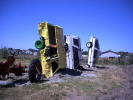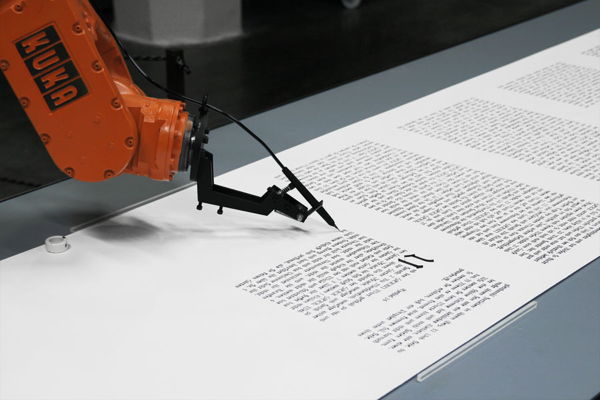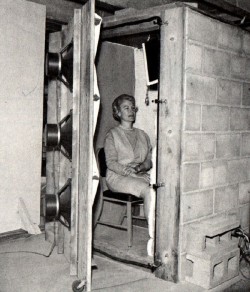Technology
Sonic Boom Simulation Chamber
During the 1960s NASA sponsored research into the effect of sonic booms on human subjects. This was in response to growing concern about "the nature of the boom phenomena" as supersonic aircraft were flying with increasing frequency. Shown in the picture is one subject (unidentified) about to be locked inside the "Sonic Boom Simulation Chamber."I like the juxtaposition of the prim-and-proper woman and the massive audio system. Unfortunately there aren't any pictures of what she looked like after being repeatedly blasted with simulated sonic booms.
The image comes from NASA Contractor Report CR-1192, "Relative Annoyance and Loudness Judgments of Various Simulated Sonic Boom Waveforms."
Posted By: Alex - Wed Aug 20, 2008 -
Comments (2)
Category: Science, Experiments, Technology
13 Things That Don’t Make Sense
Posted By: Paul - Sun Aug 10, 2008 -
Comments (3)
Category: Science, Technology, Unsolved Mysteries, Books
Telemegaphone Dale

When you dial the Telemegaphone’s phone number the sound of your voice is projected out across the fjord, the valley and the village of Dale below.
I wonder how many collect calls it receives?
Posted By: Alex - Fri Aug 08, 2008 -
Comments (1)
Category: Buildings and Other Structures, Technology
Robotic and Redneck Stonehenge
Steve Norris has built a Stonehenge Robotic Digital Clock. I don't think it would work so well as a bedside timepiece (the whirring of it might keep you up at night), but it would definitely be something you could show off to your friends. It would be even cooler if a version of this were built that was the actual size of Stonehenge. (via OhGizmo!)
Posted By: Alex - Tue Aug 05, 2008 -
Comments (0)
Category: Buildings and Other Structures, Inventions, Technology, Video
Riding the Rails
Of course we all know that the image of a hand-pumped railroad trolley is a comedy staple. But I find the notion of special little motorized vehicles adapted to ride the rails just as funny. As you might predict, there's an organization dedicated to hobbyists and collectors of these miniature rail-mounted transports, and it's to be found here.My local newspaper has a great article about a fellow who restored the vehicle pictured to the right.
I imagine a Farelly Brothers movie in which the hero confounds the bad guys by making his unpredictable escape in such a vehicle--at a whopping 5 MPH!
Posted By: Paul - Mon Aug 04, 2008 -
Comments (2)
Category: Eccentrics, Collectors, History, Inventions, Technology, Travel, Transportation, 1950s, Cars
Gamucci Electronic Cigarettes

So basically it's a miniaturized fog gun that you hold in your mouth. Sounds like a swell way to join the revolution!
Posted By: Alex - Tue Jul 29, 2008 -
Comments (3)
Category: Technology, Products
Jetpack Dreams
That most silly and pointless and inutile, yet much desired of flight mechanisms, the jetpack, is back in the news. You can read a New York Times piece about the latest model here.And a review copy of this book recently arrived in my mailbox, portending lots of fun.
Yet such mechanisms pale before the magnificently insane accomplishment of Yves Rossy, who, a couple of years ago, basically turned himself into Iron Man. Watch his jet-powered flight below.
Posted By: Paul - Tue Jul 29, 2008 -
Comments (4)
Category: Eccentrics, Flight, Inventions, Literature, Science Fiction, Movies, Obsessions, Pop Culture, Technology, Travel, Yesterday’s Tomorrows
Robotic Writing Monk
The relentless march of progress continues. Now monks have been automated, thanks to The Bible Scribe.Start looking for a new job, Brother.

Posted By: Alex - Wed Jul 23, 2008 -
Comments (0)
Category: Art, Religion, Technology, AI, Robots and Other Automatons, Books
The Cow Whisperer
I suspect cows are going to become a theme here at WU. They're ubiquitous and silly and important. Those are three good criteria for inclusion here. Hey, if cows were good enough for Gary Larson humor, they're good enough for us!The latest news is that they're demanding headphones as they graze! Not sure if iPods are included. Read the article here.
Then watch the video of "The Cow Whisperer" here.
Posted By: Paul - Wed Jul 23, 2008 -
Comments (5)
Category: Agriculture, Food, Science, Experiments, Technology, Cows
Looks Like a Robot
The Looks Like A Robot Flickr pool does not contain any photos of robots. What it does contain is over 300 pictures of objects that look like robots. Lots of fun to browse. (Thanks, Bob!)
Posted By: Alex - Wed Jul 23, 2008 -
Comments (0)
Category: Technology

| Who We Are |
|---|
| Alex Boese Alex is the creator and curator of the Museum of Hoaxes. He's also the author of various weird, non-fiction, science-themed books such as Elephants on Acid and Psychedelic Apes. Paul Di Filippo Paul has been paid to put weird ideas into fictional form for over thirty years, in his career as a noted science fiction writer. He has recently begun blogging on many curious topics with three fellow writers at The Inferior 4+1. Contact Us |






